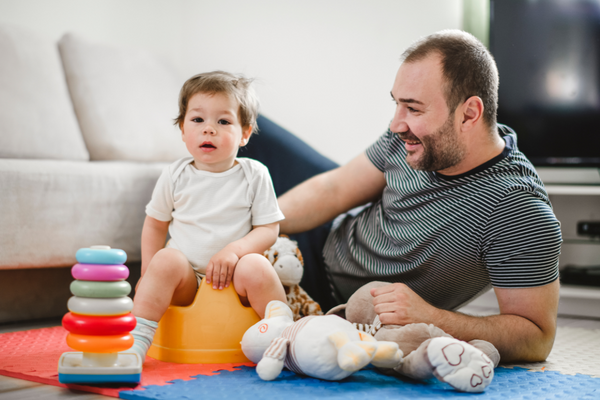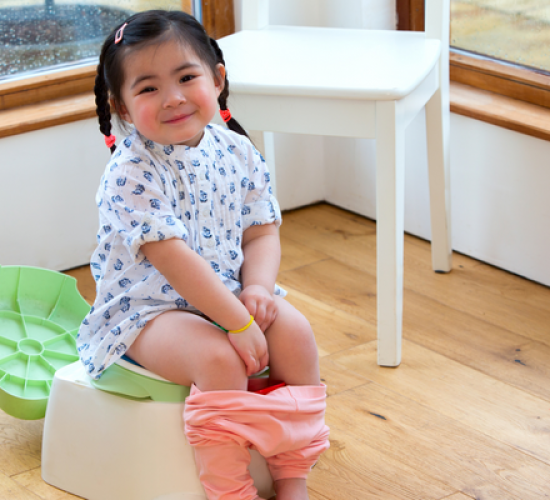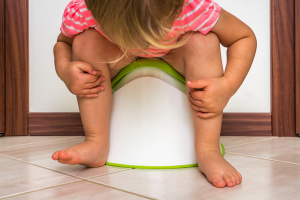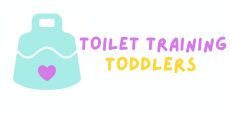Elimination Communication (Infant Potty Training)
Elimination Communication: Everything You Need To Know
Are you looking to learn about elimination communication potty training for your little one? You’ve come to the right place!
This guide will cover everything you need to know about Elimination Communication
- What is it?
- What are the benefits?
- How does it work?
- What you need to get started
By the end of this article you and your baby will be saying goodbye to full-time diapering.
Let’s get started!
Disclaimer: This blog post contains affiliate links . If you use them, we might be rewarded credit or a commission of the sale. Please note that we only recommend tools that we personally use and love and we always have our readers’ best interest at heart.
What Is Elimination Communication?
Elimination Communication (also known as Infant Potty Training) is an age-old parenting technique involving timing, signals, and cues to communicate with your baby about their elimination needs.
The goal of elimination communication is to prevent or reduce the need for diapers by helping your baby understand their body’s natural cues when needing to pee and poop.
This method is usually practiced when the baby is at least six months old and can be used until 18 or 24 months.
Why Should I Try The Elimination Communication Method?
There are many reasons why parents choose to practice elimination communication with their babies.
For some, it is a way to create a deeper bond with their child. For others, it is a way to reduce their environmental impact or to save money on diapers.

But the most important reason to consider elimination communication is that it is the healthiest way for your baby to eliminate their waste.
Remember, babies wearing diapers for too long are at a higher risk of diaper rash, urinary tract infections, and other health problems.
So, it’s beneficial from a baby’s health standpoint.
How Does Elimination Communication Work?
Elimination communication is a baby-led potty training technique involving close communication between the parent and the baby. Yes! Your baby will be leading the technique, but it’s your job to understand them!
Let’s see how it works.
Step 1:
The first step is to become attuned to your baby’s patterns and signals.
Each baby is different, so it will take some time to learn what signals mean that your baby needs to go.
Signals can be physical, such as squirming, grunting, or facial expressions. Or, they can be behavioral, such as suddenly stopping play or becoming fussy.
Step 2:
Once you understand your baby’s signals, you can begin to respond to them. If you see your baby signaling that they need to pee or poop, you can hold them over a potty or take them to the bathroom.
Make sure that you are using a comfortable position for your baby. For example, you may need to hold them in a standing position if they are not yet able to sit up on their own. Or, your baby may need to sit in a deep squat position to poop properly.
Find what works best for them!
Step 3:
If your baby is over the potty and doesn’t understand what to do, you may give them cues to start eliminating. Cues can range from saying “go potty” to making a “shhhhhh” or “ssss” sound when you want them to go.
Over time, babies start associating your cues with the “act” and know when is the right time to pee or poop.
The most important thing, however, is that you are consistent with your cue.
Step 4:
Once your baby is done passing urine or excreting, it is time to praise them for understanding your cue.
Give them positive reinforcement through verbal praise, clapping or a small treat or sticker.
That’s it– it’s just a carefully executed game of signals and cues. But, besides understanding your baby’s signals and cueing them smartly, you must master two other aspects for best results: timing and intuition!
Timing:
Every child has their own preferred time to go. Some babies need to pee immediately after waking up or drinking water, while others would take 5, 10, 20, or more minutes.
Similarly, babies have their set times for pooping. You need to be very good at remembering when your baby usually feels the urge to poop.
Intuition:
You need to be highly intuitive and know your baby’s “mood.” For instance, when there is a change in your baby’s sleep or eating schedule, their potty schedule will change with it.
They might not give you the usual signals in such cases. Your intuition plays an important role!
What Do You Need To Get Started?
Here’s what you need to get started with elimination communication potty training:
- A potty, bowl, or a baby toilet seat:
You can use a potty, toilet seat, or even a small bowl. Some parents prefer to use a potty because it’s small and can be easily carried around the house. It’s also less intimidating for the baby.

Toilet training seats are also a good option because they fit right on top of your toilet seat and have a smaller opening. This can be a good transition for babies ready to move from the potty to the toilet.
- Easy-to-remove or crotchless clothing:
This will make it easy for you to access your baby’s bottom when it’s time to go. So, buy and stock up on clothing that can be easily removed, like onesies, leggings etc. - Wipes:
Even if you are using elimination communication, keeping diapers and wipes handy is always a good idea. Sometimes your baby will go without any warning, and you might not be able to make it in time! - Reward Supplies:
As we mentioned earlier, treats or stickers as a reward can be a great way to potty train your baby. So, make sure you always have something to keep them encouraged.
What Are The Benefits?
Elimination communication has several benefits for both the baby and the parent.
Benefits For Babies:
- They get used to the feeling of being clean and dry.
- They learn to control their bodily functions better.
- They are less likely to get UTI or other infections.
- They have fewer diaper rashes.
Benefits For Parents:
- It saves money – you don’t have to keep buying diapers!
- It’s eco-friendly – you’re not throwing away diapers every day.
- It’s convenient – you don’t have to carry around a diaper bag everywhere you go.
- It saves you having to potty train a toddler (which can come with a whole range of challenges!)

When To Start Elimination Communication?
There’s no set time to start with elimination communication. However, it’s ideal when your baby is between 6 and 10 months old.
This is because at this age, babies are more aware of their bodily functions and can start understanding cues and signals. They are also at an age where they can sit up unassisted.
Still, you can start earlier or later than this – it’s just a matter of personal choice. Start whenever you feel your baby is ready!
But remember, elimination communication requires a lot of patience, love, and practice!
